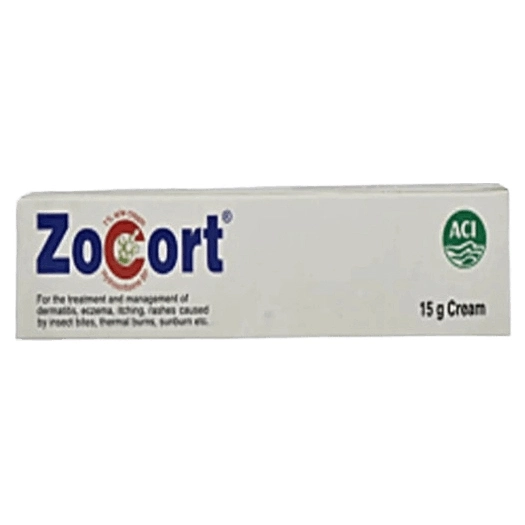Indications
The anti-inflammatory activity of Zocort is its main therapeutic property. It also has immunosuppressant and antimitotic actions. Zocort is indicated in:
- Primary irritant dermatitis
- Contact allergic dermatitis
- Eczema: atopic, infantile, discoid, stasis
- Seborrheic dermatitis
- Lichen simplex and pruritus ani
- Flexural psoriasis
- Skin irritations, itching and rashes, for example those caused by insect bites, minor thermal burns, sunburn, etc
* রেজিস্টার্ড চিকিৎসকের পরামর্শ মোতাবেক ঔষধ সেবন করুন
Pharmacology
Hydrocortisone binds to the cytosolic glucocorticoid receptor. After binding the receptor the newly formed receptor-ligand complex translocates itself into the cell nucleus, where it binds to many glucocorticoid response elements (GRE) in the promoter region of the target genes. The DNA bound receptor then interacts with basic transcription factors, causing the increase in expression of specific target genes. The anti-inflammatory actions of corticosteroids are thought to involve lipocortins, phospholipase A2 inhibitory proteins which, through inhibition arachidonic acid, control the biosynthesis of prostaglandins and leukotrienes. Specifically glucocorticoids induce lipocortin-1 (annexin-1) synthesis, which then binds to cell membranes preventing the phospholipase A2 from coming into contact with its substrate arachidonic acid. This leads to diminished eicosanoid production. The cyclooxygenase (both COX-1 and COX-2) expression is also suppressed, potentiating the effect. In other words, the two main products in inflammation Prostaglandins and Leukotrienes are inhibited by the action of Glucocorticoids. Glucocorticoids also stimulate the lipocortin-1 escaping to the extracellular space, where it binds to the leukocyte membrane receptors and inhibits various inflammatory events: epithelial adhesion, emigration, chemotaxis, phagocytosis, respiratory burst and the release of various inflammatory mediators (lysosomal enzymes, cytokines, tissue plasminogen activator, chemokines etc.) from neutrophils, macrophages and mastocytes. Additionally the immune system is suppressed by corticosteroids due to a decrease in the function of the lymphatic system, a reduction in immunoglobulin and complement concentrations, the precipitation of lymphocytopenia, and interference with antigen-antibody binding.
Dosage & Administration
Hydrocortisone Acetate should be applied in a small quantity to the affected area 2 or 3 times daily.
* রেজিস্টার্ড চিকিৎসকের পরামর্শ মোতাবেক ঔষধ সেবন করুন
Contraindications
- Infections: bacterial, viral, fungal.
- Skin ulcers.
- Hypersensitivity to the preparation.
Side Effects
Zocort 1% cream is usually well-tolerated, but if signs of hypersensitivity appear, application should be stopped.
Pregnancy & Lactation
There is inadequate evidence for safety in human pregnancy. It is recommended that topical corticosteroids should not be used extensively during pregnancy. It is highly unlikely that sufficiently high blood levels of Hydrocortisone are achieved during topical therapy to reach breast milk.
Precautions & Warnings
In infants and children, long-term continuous topical therapy should be avoided where possible, as adrenal suppression can occur. As with all corticosteroids, prolonged application to the face is undesirable.
Overdose Effects
Acute overdosage is very unlikely to occur, however, in the case of chronic overdosage or misuse, the features of hypercorticism may appear and in this situation topical steroids should be discontinued.
Therapeutic Class
Other Topical corticosteroids
Storage Conditions
Store in a cool and dry place, away from light. Keep out of reach of children.

